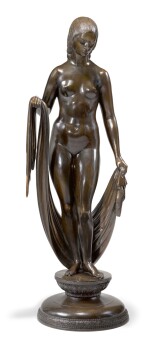American Art
American Art

Property of Private Collection
PAUL MANSHIP | BRISEIS
Auction Closed
June 26, 03:10 PM GMT
Estimate
100,000 - 150,000 USD
Lot Details
Description
Property of Private Collection
PAUL MANSHIP
1885 - 1966
BRISEIS
inscribed Paul Manship/©1916 (on the base) and stamped ROMAN BRONZE WORKS N-Y- (along the base)
bronze with dark brown patina
height: 44 ½ inches (113 cm)
Modeled in 1916.
Spanierman Galleries, New York
Acquired by the present owner from the above, 1997
Paul Vitry, Paul Manship: Sculpteur Américain, Paris, France, 1927, p. 39, another example illustrated pl. 13
Edwin Murtha, Paul Manship, New York, 1957, no. 89, p. 158, another example illustrated pl. 16
J. F. Hunter, G. Kittleson, L. Klein and S. Levy, Paul Manship: Changing Taste in America, Saint Paul, Minnesota, 1985, no. 99, pp. 138, 139, another example illustrated
John Manship, Paul Manship, New York, 1989, pp. 63, 205
The present work is one of three 44 inch casts of Briseis, one of which Manship displayed in the dining room of his townhouse on East 72nd Street in New York. Six copies of a reduced version were also produced. According to Greek mythology, Briseis was a princess who lost her family and was taken captive by Achilles during the Trojan War.
Paul Manship’s appreciation for Archaic Greek art, defined by its naturalistic style and reflecting influences from Egypt and India, developed during a three year fellowship at the American Academy in Rome from 1909-1912. Upon his return to New York, Manship embarked on a series of figural works in which he translated the Greek aesthetic into a unique vision that bridged the gap between the traditional and modern, including the present Briseis conceived in 1916. The artist's primary concern lay in the purity of form, where each element was considered and perfected to achieve a manifestation that was distinctly naturalistic, yet simplified and contemporary.
Harry Rand writes, "Manship recognized 1916 as the year of his artistic maturity. His experiments with Indian art led him to emphasize balletic movement in space and to sharply silhouette his subjects to heighten a clearly defined outline; confined areas of decoration animate the sculptures' surfaces. Some critics admired suggestions of the same surface quality that distinguishes early Chinese bronzes; other noted the treatment of hair and the orderly arrangements of drapery indicative of the archaic Greek. Manship seemed to express modern ideas in terms of the primitive" (Paul Manship, Washington, D.C., 1989, p. 48).
